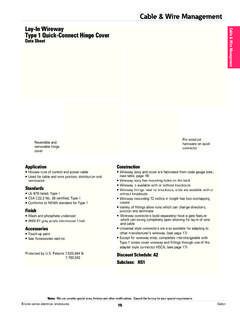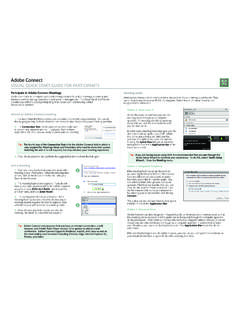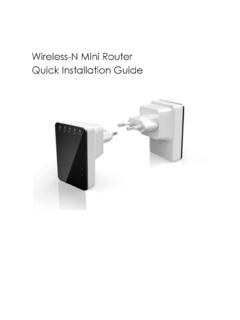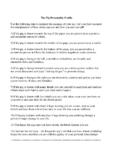Transcription of Rosemount 2051 Pressure Transmitter and Rosemount …
1 quick Start Guide00825-0400-4101, Rev ADOctober 2016 Rosemount 2051 pressure transmitter and rosemount 2051cf Series Flowmeter with PROFIBUS PA Page 1 Monday, October 17, 2016 4:24 AMOctober 20162 quick Start GuideNOTICEThis installation guide provides basic guidelines for Rosemount 2051 Transmitters. It does not provide instructions for configuration, diagnostics, maintenance, service, troubleshooting, Explosion-proof, Flame proof, or intrinsically safe ( ) installations. Refer to the Rosemount 2051 PROFIBUS PA Reference Manual for more instruction. This manual is also available electronically on could result in death or serious of this Transmitter in an explosive environment must be in accordance with the appropriate local, national, and international standards, codes, and practices. Review the approvals section of the Rosemount 2051 PROFIBUS PA Reference Manual for any restrictions associated with a safe installation.
2 In an Explosion-proof/Flameproof installation, do not remove the Transmitter covers when power is applied to the unit. Process leaks may cause harm or result in death. To avoid process leaks, only use the O-ring designed to seal with the corresponding flange adapter. Electrical shock can result in death or serious injury. Avoid contact with the leads and the terminals. High voltage that may be present on leads can cause electrical entries Unless marked, the conduit/cable entries in the Transmitter housing use a 1/2 14 NPT thread form. Only use plugs, adapters, glands, or conduit with a compatible thread form when closing these Mount the Transmitter .. 3 Consider housing rotation .. 7 Set jumpers and switches .. 8 Connect wiring and power up .. 8 Basic configuration .. 11Tr i m t h e t r a n s m i t t er .. 15 Product Certifications .. Page 2 Monday, October 17, 2016 4:24 AMQuick Start Guide3 October Mount the Liquid applications1.
3 Place taps to the side of the Mount beside or below the Mount the Transmitter so the drain/vent valves are oriented Gas applications1. Place taps in the top or side of the Mount beside or above the Steam applications1. Place taps to the side of the Mount beside or below the Fill impulse lines with Page 3 Monday, October 17, 2016 4:24 AMOctober 20164 quick Start GuideFigure 1. Mounting OptionsRosemount 2051 CPanel mount(1)1. Panel bolts are customer mountCoplanar flangeTraditional flangeRosemount Page 4 Monday, October 17, 2016 4:24 AMQuick Start Guide5 October Bolting considerationsIf the Transmitter installation requires assembly of the process flanges, manifolds, or flange adapters, follow these assembly guidelines to ensure a tight seal for optimal performance characteristics of the transmitters. Use only bolts supplied with the Transmitter or sold by Emerson as spare parts.
4 Figure 2 illustrates common Transmitter assemblies with the bolt length required for proper Transmitter 2. Common Transmitter AssembliesA. Transmitter with coplanar flangeB. Transmitter with coplanar flange and optional flange adaptersC. Transmitter with traditional flange and optional flange adaptersD. Transmitter with coplanar flange and optional manifold and flange adaptersBolts are typically carbon steel or stainless steel. Confirm the material by viewing the markings on the head of the bolt and referencing Table 1. If bolt material is not shown in Table 1, contact the local Emerson Process Management representative for more information. Use the following bolt installation procedure:1. Carbon steel bolts do not require lubrication and the stainless steel bolts are coated with a lubricant to ease installation. However, no additional lubricant should be applied when installing either type of bolt.
5 2. Finger-tighten the Torque the bolts to the initial torque value using a crossing pattern. See Table 1 for initial torque Torque the bolts to the final torque value using the same crossing pattern. See Table 1 for final torque Verify that the flange bolts are protruding through the isolator plate before applying Pressure . ABCD4 (44 mm)4 (44 mm)4 (73 mm)4 (44 mm)4 (38 mm)4 (57 mm) Page 5 Monday, October 17, 2016 4:24 AMOctober 20166 quick Start O-rings with flange adaptersWhenever the flanges or adapters are removed, visually inspect the O-rings. Replace them if there are any signs of damage, such as nicks or cuts. If you replace the O-rings, re-torque the flange bolts and alignment screws after installation to compensate for seating of the PTFE 1. Torque Values for the Flange and Flange Adapter BoltsBolt materialHead markingsInitial torqueFinal torqueCarbon Steel (CS) 300 in-lb650 in-lbStainless Steel (SST)150 in-lb300 in-lbFailure to install proper flange adapter O-rings may cause process leaks, which can result in death or serious injury.
6 The two flange adapters are distinguished by unique O-ring grooves. Only use the O-ring that is designed for its specific flange adapter, as shown below:A. Flange adapterB. O-ringC. PTFE based (profile is square)D. Elastomer (profile is round)B7M316316316SW316 STM316RB8 MABR osemount 3051S/3051 Page 6 Monday, October 17, 2016 4:24 AMQuick Start Guide7 October Environmental seal for housingThread sealing (PTFE) tape or paste on male threads of conduit is required to provide a water/dust tight conduit seal and meets requirements of NEMA Type 4X, IP66, and IP68. Consult factory if other Ingress Protection ratings are M20 threads, install conduit plugs to full thread engagement or until mechanical resistance is In-line gage Transmitter orientationThe low side Pressure port (atmospheric reference) on the in-line gage Transmitter is located in the neck of the Transmitter , behind the housing.
7 The vent path is 360 around the Transmitter between the housing and sensor. (See Figure 3.) Keep the vent path free of any obstruction, including but not limited to paint, dust, and lubrication by mounting the Transmitter so that the process can drain 3. In-line Gage Low Side Pressure PortA. Low side Pressure port (atmospheric reference) Consider housing rotationTo improve field access to wiring or to better view the optional LCD display:1. Loosen the housing rotation set First rotate the housing clockwise to the desired location. If the desired location cannot be achieved due to thread limit, rotate the housing counter clockwise to the desired location (up to 360 from thread limit).3. Retighten the housing rotation set 4. Transmitter Housing Set ScrewA. Housing rotation set screw (5/64-in.) Page 7 Monday, October 17, 2016 4:24 AMOctober 20168 quick Start Set jumpers and SecurityAfter the Transmitter is configured, you may want to protect the configuration data from unwarranted changes.
8 Each Transmitter is equipped with a security jumper that can be positioned ON to prevent the accidental or deliberate change of configuration data. The jumper is labeled Security . The security jumper also prevents changes made using the Local Operator SimulateThe simulate jumper is used in conjunction with the analog input (AI) block. This jumper is used to simulate the Pressure measurement and is used as a lock-out feature for the AI block. To enable the simulate feature, the jumper must be moved to the ON position after power is applied. This feature prevents the Transmitter from being accidentally left in simulate 5. Transmitter Jumper Connect wiring and power upUse the following steps to wire the Transmitter :1. Remove the housing cover on the field terminals Connect the power leads to the terminals indicated on the terminal block label. Power terminals are polarity insensitive - connect positive or negative to either terminal3.
9 Ensure full contact with Terminal Block screw and washer. When using a direct wiring method, wrap wire clockwise to ensure it is in place when tightening the terminal block use of a pin or a ferrule wire terminal is not recommended as the connection may be more susceptible to loosening over time or under 2051 PROFIBUS PA Page 8 Monday, October 17, 2016 4:24 AMQuick Start Guide9 October 20164. Ensure proper grounding. It is important that the instrument cable shield: Be trimmed close and insulated from touching the Transmitter housing Be connected to the next shield if cable is routed through a junction box Be connected to a good earth ground at the power supply end5. Plug and seal unused conduit If applicable, install wiring with a drip loop. Arrange the drip loop so the bottom is lower than the conduit connections and the Transmitter Replace the housing 6.
10 TerminalsA. Power terminalsB. Ground Page 9 Monday, October 17, 2016 4:24 AMOctober 201610 quick Start GuideFigure 7. Signal wiring groundingDo not run signal wiring in conduit or open trays with power wiring, or near heavy electrical equipment. Grounding terminations are provided on the outside of the electronics housing and inside the terminal compartment. These grounds are used when transient protect terminal blocks are installed or to fulfill local regulations. See Step 2 below for more information on how the cable shield should be Remove the field terminals housing Connect the wiring pair and ground as indicated in Figure 8. The cable shield should: Be trimmed close and insulated from touching the Transmitter housing. Continuously connect to the termination point. Be connected to a good earth ground at the power supply 6234 ft (1900 m) max (depending on cable characteristics)B.
















